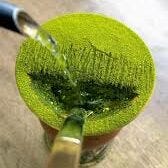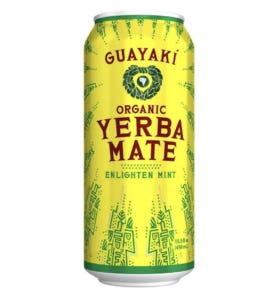Is drinking holly Messi’s superpower?
definitely a different superpower than Maradona 👃
I absolutely love coffee. Every morning, I would wake up and make a liter of whatever nice beans I would buy in (normally Onyx, BRC, Dark Matter or Metric). Like many folks, once I get that first sip, I would not stop until that Chemex ran dry. My stomach would turn sour and I would be energetically in a nauseated state that only time and water would cure. I felt like a rat in a Skinner box – going back to hit the button to be fed for some kind of mouth pleasure, but also being Skinner himself, seeing the conditioning behavior that hurt me so and letting it happen. I talk about this like it’s a long time ago, but this was like…yesterday.
I hopelessly love the flavor of coffee and whatever boost can still be generated through caffeine-fried neurons, but my stomach almost never approves of the acidity that coffee brings with it. About a decade ago though, I was introduced to yerba maté and I wasn’t initially a huge fan. Over time and trying different brands and preparations made it a drink I’d reached for but, even more so over the last four years. Messi and many Argentine, Brazilian, Uruguayan and other Southern Cone footballers will be seen with huge thermos and mounds of green bowls.
Since Messi finally won the World Cup in 2022, the football world turned its attention to yerba maté with greater interest. You now see the French and English National teams slurping down leaf juice on the regular, the latter ditching their previous tea drinking ways.
Despite my efforts to write a football blog, I want to hone in on this drink and its even lesser known cousins: guayusa, yaupon and kudingcha.
yerba mate: the trending holly
Yerba maté is part of the holly genus Ilex and was cultivated and consumed by the Guaraní and Tupi communities of what is now Paraguay, long before Spanish colonization. It’s now prepared mainly by putting in the dried leaves of the yerba into a maté (a dried calabash gourd). A fritted straw is placed (and never moved!) into the leaves and warm water is poured over and drank. This is repeated until the leaves are washed of flavor (lavado in Spanish) or you’re just over it. You’ll hear folks call it either yerba, yerba maté or maté, which can be confusing because the first and second refers only to the leaves and the third is actually the name of the dried gourd it is drunk from. Because of this repetitive steeping, maté is a communal drink. You’ll pour some for your friends and take back the gourd, refilling it and dishing it back out.
Each country processes the leaves differently and Paraguayan maté may taste very different from Brazilian maté. The Yerba Mate Lab does a very good job explaining and reviewing the different types of processes and all the different brands that you can purchase. The Instagram page is pretty wild too and has taught me how to prepare the Brazilian chimarrão-style maté.
Why does anyone drink this if you didn’t grow up in one of these South American cultures though? The flavor ranges from bitter to smokey to fresh. The aroma can also range from campfire-side, faint caramel, lemons, limes and whole wheat bread. There is such a range of flavors you can get from different brands and many have blends with tea, citrus peels, aromatic flowers and more that might be better gateways for you. Importantly, maté has slightly less caffeine than coffee and tea, and also has theobromine. Theobromine is also considered one of “happy chemicals” in chocolate ( or the poisonous one to dogs) and is a slightly less intense stimulant that takes longer to clear from your system than caffeine. It’s also loaded with polyphenols and other potent antioxidants that rival green tea and matcha. This combination makes yerba maté have the strength of coffee, the euphoria of dark chocolate, and the relaxation of green tea.
Not to ride the Ozempic train, but there are studies (1, 2, 3) looking at how maté follows the GLP-1 pathway to promote satiety and lower body weight in mice. This isn’t really why I drink it, but it is super interesting to see the Western world turn its gaze on Novo Nodisk’s wunderkind and how much it’s permeated popular culture. Even more interesting is seeing how this has impacted the Danish economy, with the drug company’s value more than its home country’s GDP.
Whatever your reason, try yerba maté because it’s a great pick me up and worth the gastronomic deep dive. Cans of Guayakí may be a good place to start, then infusing the leaves like you would tea and finally work your way up to a gourd!
what are these other hollys though?
Yaupon
Since delving more into maté, I wanted to learn more about other infusions that didn’t use tea leaves (Camellia sinensis) or coffee beans. My first foray into this was back in 2015 when NPR ran an article and short audio piece on yaupon. I was fascinated by the fact that we had a caffeinated tea that was native to North America, that was forgotten or refused. It grows from North Carolina to Eastern Texas and until relatively recently was only foraged. There are now multiple different yaupon dealers where you can buy many varieties. Its taste is similar to yerba maté but there is more of a green apple note to the unroasted varieties that I really enjoy. It has many of the other stimulant and antioxidant benefits that maté has as well. I enjoy mixing parts of this into my gourd as well to get a more complex flavor in the morning.
Kudingcha
When my brother went to Taiwan, I had been chatting about this exact post and how I was fascinated by the range of Ilex hollys and found that in China and Japan there was another form consumed: kuding. He had never tried it but said he’d look in Taiwan for these rolled up leaves, meaning “bitter nail”. Boy, does that translation hit the spot. This is one of the more bitter infusions I’ve ever had and is not for the faint of heart. Kudingcha isn’t always made with Ilex hollys, but the Chinese version almost always is. The stimulant payoff for such a bitter drink is actually not there – this holly is caffeine-free! Despite this, it does grow on you and after a few steeps of the same leaves, it mellows and is a very pleasant sipper.
Guayusa
If you’re not in the Southern Cone, you would end up drinking the guayusa holly plant. It mainly is grown in the northern Amazonian countries of Ecuador, Peru and Colombia. Much like yerba maté, it is an ancient infusion that predates the Colonization of that region. You can steep it or drink it in a gourd (which I now tend to drink everything out of anyway) and you get these clean, earthy notes that can then fold into an almost biscuity savoriness. It has even more stimulants than coffee, but also has l-theanine, which nootropic drink makers have been putting into their coffees to “mellow out” the high of caffeine. With it being naturally integrated here and with so many antioxidants, theobromine and such, you don’t need to reach for “super coffee” but just a refreshing guayusa.
Hollys provide such a wonderful dimension to my morning and early afternoon routines. I understand why so many footballers are on the maté train and, while it may be a trend, it’s finally getting its day in the spotlight that it deserves. The hope is that this trend for one raises the interest for the rest and provides new ways of caffeinating your world. With coffee’s uncertain future, it’s worth diversifying how we wake up in the morning. I hope you try them out and let me know how you liked it!





